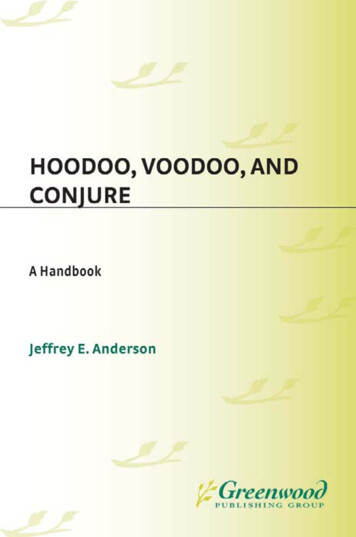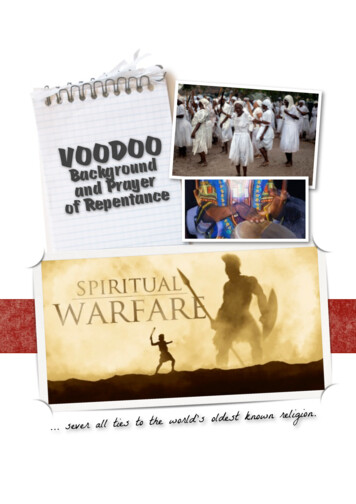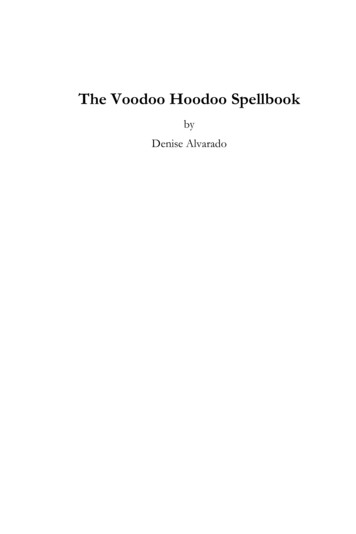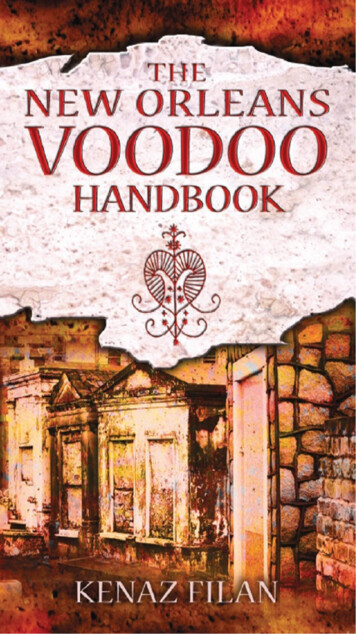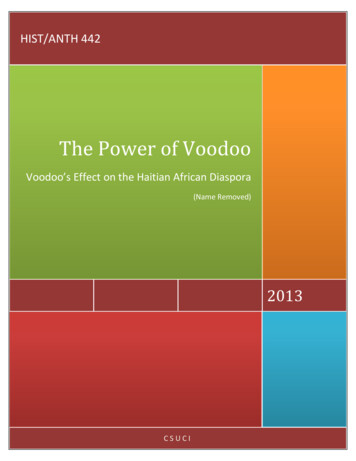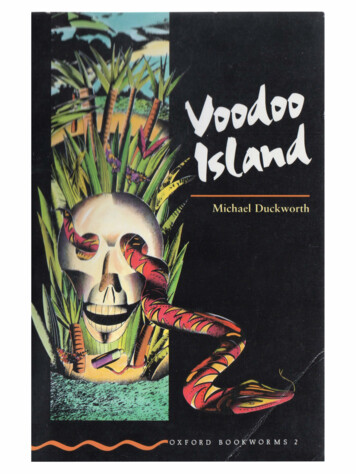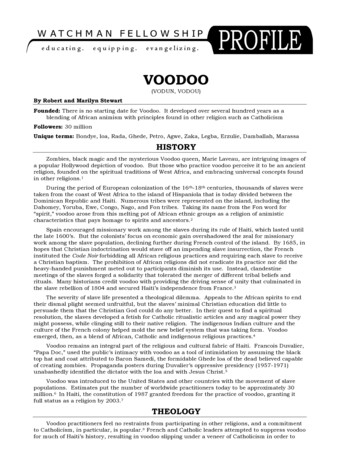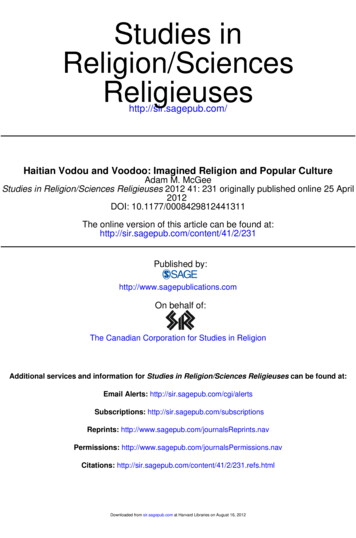
Transcription
Studies om/Haitian Vodou and Voodoo: Imagined Religion and Popular CultureAdam M. McGeeStudies in Religion/Sciences Religieuses 2012 41: 231 originally published online 25 April2012DOI: 10.1177/0008429812441311The online version of this article can be found d by:http://www.sagepublications.comOn behalf of:The Canadian Corporation for Studies in ReligionAdditional services and information for Studies in Religion/Sciences Religieuses can be found at:Email Alerts: http://sir.sagepub.com/cgi/alertsSubscriptions: http://sir.sagepub.com/subscriptionsReprints: ions: tions: ownloaded from sir.sagepub.com at Harvard Libraries on August 16, 2012
Version of Record - Jun 12, 2012OnlineFirst Version of Record - Apr 25, 2012What is This?Downloaded from sir.sagepub.com at Harvard Libraries on August 16, 2012
Haitian Vodou andVoodoo: ImaginedReligion and PopularCultureStudies in Religion / Sciences Religieuses41(2) 231–256ª The Author(s) / Le(s) auteur(s), 2012Reprints and permission/Reproduction et I: 10.1177/0008429812441311sr.sagepub.comAdam M. McGeeHarvard UniversityAbstract: Vodou is frequently invoked as a cause of Haiti’s continued impoverishment.While scholarly arguments have been advanced for why this is untrue, Vodou is persistentlyplagued by a poor reputation. This is buttressed, in part, by the frequent appearance inpopular culture of the imagined religion of ‘‘voodoo.’’ Vodou and voodoo have entwineddestinies, and Vodou will continue to suffer from ill repute as long as voodoo remains anoutlet for the expression of racist anxieties. The enduring appeal of voodoo is analyzedthrough its uses in touristic culture, film, television, and literature. Particular attention isgiven to the genre of horror movies, in which voodoo’s connections with violence againstwhites and hypersexuality are exploited to produce both terror and arousal.Résumé : Le Vodou est souvent invoqué comme une cause de la misère persistanted’Haı̈ti. Bien que les arguments académiques ont été avancés pour prouver le contraire,le Vodou en générale est toujours mal compris et souvent décrié. Les idées erronées duVodou sont étayées, en partie, par l’utilisation fréquente dans la culture populaire de lareligion imaginaire du « voodoo ». Le Vodou et le voodoo possèdent des destinsenlacés, et le Vodou continuera à souffrir d’une mauvaise réputation aussi longtempsque le voodoo reste un instrument pour l’expression des anxiétés racistes. L’attraitdurable du voodoo est analysé ici à travers ses usages dans la culture touristique, lecinéma, la télévision, et la littérature. Une attention particulière est donnée au genredes films d’horreur, dans lequel les connexions du voodoo avec la violence contre lesblancs et l’hypersexualité sont exploitées pour produire, en même temps, la terreuret l’excitation sexuelle.Corresponding author / Adresse de correspondance :Adam McGee, Department of African and African American Studies, Harvard University, Barker Centre,12 Quincy Street, Cambridge, MA 02138, United StatesEmail: amcgee@fas.harvard.eduDownloaded from sir.sagepub.com at Harvard Libraries on August 16, 2012
232Studies in Religion / Sciences Religieuses 41(2)KeywordsVodou, voodoo, zombies, imagined religion, cultural studies, race studies, film, television,literature, tourism, New Orleans, Marie LaveauMots clésLe Vaudou, le voodoo, les zombies, la religion imaginaire, les études culturelles, lesétudes sur la race, le cinéma, la télévision, la littérature, le tourisme, NouvelleOrléans, Marie Laveau. . . the prisoners all proved to be men of a very low, mixed-blooded, and mentally aberranttype. Most were seamen, and a sprinkling of negroes and mulattos, largely West Indians orBrava Portuguese from the Cape Verde Islands, gave a colouring of voodooism to the heterogeneous cult. . . . Degraded and ignorant as they were, the creatures held with surprisingconsistency to the central idea of their loathesome faith.H.P. Lovecraft, ‘‘The Call of Cthulhu’’ (2008 [1928])Introduction and TheoryFollowing the Goudougoudou of 12 January 2010,1 Haitian culture and religion fell,once again, under the focus of the international media and opinion makers. Not surprisingly, many succumbed to the seemingly irresistible temptation to recycle many of thestereotypes about Haitian Vodou. This urge is exemplified by David Brooks’s New YorkTimes op-ed, in which he opined that Haitian Vodou was the cause of many of Haiti’swoes. Citing Lawrence Harrison as his inspiration, Brooks wrote (on 14 January 2010),2Haiti, like most of the world’s poorest nations, suffers from a complex web of progressresistant cultural influences. There is the influence of the voodoo religion, which spreadsthe message that life is capricious and planning futile. . . . We’re all supposed to politelyrespect each other’s cultures. But some cultures are more progress-resistant than others, anda horrible tragedy was just exacerbated by one of them.The implication was that, in a country rife with superstition, our well-meaning effortswould succeed only in wasting dollars, as Haiti would inevitably backslide into itsheathen ways.These views of Haitian Vodou do not, however, exist in a kind of suspended animation, latent until activated by crisis. Rather, they are continuously at play in our popularculture, where they manifest most frequently in references to an imagined religion called‘‘voodoo.’’ Principally an invention of Hollywood—and of travel writers long beforethat—voodoo has power in the imaginations of many, in spite of the fact that it has littleor no basis in fact. This imagined religion serves as a venue for the expression of moreor-less undiluted racial anxieties, manifested as lurid fantasies about black peoples. Isuggest that these two religions—Haitian Vodou and imagined voodoo—have entwineddestinies. While it is of enormous value to rehabilitate the tarnished reputation of HaitianDownloaded from sir.sagepub.com at Harvard Libraries on August 16, 2012
McGee233Vodou, the real battle to be won is in the popular arena, where voodoo continues, unabated and mostly under the radar, to disseminate and reinforce centuries-old racist tropesabout blacks and black religiosity. In this paper, I analyze some of the ways that thesetropes are expressed in primarily American films, literature, television shows and touristic culture, and suggest possible directions for future research. I also theorize aboutsome of the reasons that voodoo has enjoyed such enduring appeal in popular culturalproductions.The topic of popular representations of Vodou and voodoo has received very littlescholarly attention (Murphy, 1990; Bartkowski, 1998; Hurbon, 1995). Perhaps mostnotable is Joseph Murphy’s essay ‘‘Black religion and ‘black magic’’’ (1990), whichoffers exceptional insights into the reasons behind the enduring appeal of voodoo in popular culture. Although some of my terminology differs from Murphy’s, I find that I havelittle cause to depart from his theoretical insights. However, in the intervening twentyyears, voodoo has been so routinely and diversely evoked that the scholar of this topicmust now contend with magnitudes more material than did Murphy. This is perhapsrelated to Cosentino’s prediction in 1987 that future years would experience an emergence and boom of what he called ‘‘Voodoo chic’’ (an idea to which I will return later).For the sake of this paper, when I use the term ‘‘voodoo’’ with a lower-case V, I willbe referring to the imagined religion. When referring to the religious practices of actualpeople, I will use an upper-case V. Thus do I attempt to draw a distinction between voodoo and Voodoo, the complex of indigenous African religions practiced in West Africa,particularly in the region centered around Togo and Benin. Both of these are differentfrom the use of the word Voodoo by religious reconstructionists in New Orleans (andincreasingly, throughout the United States) for their religious practices. It is unavoidablethat these shared names be a bit confusing, since that is precisely the point. While I amsympathetic to attempts to make a clearer distinction between the religion of Vodou andits imaginary doppelgänger of voodoo (Murphy, 1990; Courlander, 1988a, 1988b;Cosentino, 1987, 1988a, 1988b), it sidesteps the circumstances that have generated theneed for such a discussion in the first place—namely, that cultural agents routinely andat times purposely utilize precisely these malapropisms. Therefore, I feel compelled toutilize and attempt to make sense of these vexing terms, rather than adopt others (suchas Murphy’s ‘‘black magic’’) that have heuristic value but little application outside ofthat. I have attempted to bring some clarity by observing the above rules of capitalization. This is an orthographic distinction of my own devising, however. While ‘‘voodoo’’has been the most common spelling one finds in Anglophone popular culture, it is occasionally the case that one finds alternative spellings even though the reference is still tothis imagined faith.In New Orleans in the summer of 2009, I had dinner with friends in Muriel’s, one ofthe finer restaurants in the old French Quarter. Muriel’s occupies the northeast corner ofJackson Square and serves French-inspired Southern food. Its front dining room, overlooking Chartres Street, is decorated with antiques. The central bar area is made to looklike an outdoor courtyard festooned with vines and flowers. Upon entering the men’sbathroom, I found its stalls and urinal dividers painted with large-scale reproductionsof ve ve (Figs. 1 and 2). Ve ve are the sacred designs that are traced on the ground duringHaitian Vodou ceremonies to welcome the lwa, the divine spirits. Each lwa has a distinctDownloaded from sir.sagepub.com at Harvard Libraries on August 16, 2012
234Studies in Religion / Sciences Religieuses 41(2)Figure 1. Vèvè painted on a toilet stall of Muriel’s, New Orleans, LA. The top half is a distressed(and distressing) depiction of a vèvè for the spirit Danbala Wedo.ve ve ; the design serves as a connection between the physical world and Gine, the worldof the spirits. Ve ve are therefore considered sacred and esoteric.While the appearance of ve ve in a bathroom was especially shocking, New Orleans isa city full of references to Vodou, and its near-relative voodoo. To make matters moreDownloaded from sir.sagepub.com at Harvard Libraries on August 16, 2012
McGee235Figure 2. Vèvè painted on a toilet stall of Muriel’s, New Orleans, LA. The ornate heart is a vèvè forthe spirit Ezili Freda.confusing, one often finds terms such as Vodou, Voodoo and Hoodoo used interchangeably, with little consideration paid to how these might differ. Such distinctions matterlittle to shop owners and barkeepers whose primary interest in Vodou is as a marketablecommodity. Tourists come to New Orleans in part to be shocked by the presence ofDownloaded from sir.sagepub.com at Harvard Libraries on August 16, 2012
236Studies in Religion / Sciences Religieuses 41(2)Figure 3. Voodoo-themed mural in Marie Laveau’s Bar, New Orleans, LA.Vodou and other mysterious rites (they also come to get drunk). They often know littleenough about these traditions, and can be eager to have their wildest fantasies sold backto them. Businessmen and women are happy to oblige. One will find bars such as Loa,which features a voodoo altar, and Marie Laveau’s Bar on Decatur Street, decorated withmurals of the famed Voodoo queen writhing in various stages of undress with buxomfemale coreligionists (Fig. 3). Stores like Rev. Zombie’s House of Voodoo and MarieLaveau’s House of Voodoo (both in the French Quarter) purport to cater to the needsof Voodooists. In fact, they make their coin primarily selling trinkets and plaster saintsto tourists. These stores compete with nearly every generic tourist trap, none of which arecomplete without a display of voodoo dolls. The Historic Voodoo Museum in the FrenchQuarter, while presenting itself as a serious museum, has little sophistication and playsheavily on the belief that the more dusty and soiled a voodoo altar, the more authenticand powerful it must be. Even the Bourbon French Perfume Company, a serious businesswith an impressive historical pedigree, includes amongst its offerings a scent called‘‘Voodoo Love’’ that is claimed to be from one of Marie Laveau’s recipes. The perfumecomes with instructions to use it by applying an X over the heart and behind the left ear todraw one’s object of lust.The proliferation of signifying on voodoo led me to adopt the descriptive term ‘‘voodoo kitsch.’’3 While the term voodoo kitsch was adopted in situ as a response to myexperiences in New Orleans, I have since come to find this term useful for encompassinga broad range of portrayals of voodoo—whether in literature, film, music, art, miscellaneous objects from popular culture or in public discourse. Examples abound. There arewebsites, such as pinstruck.com, which ‘‘allows people like yourself to vent on theirfriends and enemies by sending them personalized voodoo curses via e-mail.’’ Thereis the Sarkozy voodoo doll that was the source of much hilarity when a French courtordered the manufacturer that its product must carry the warning label that sticking pinsin the Sarkozy doll may offend the president’s dignity (BBC News). A new roller coaster atDorney Park in Allentown, Pennsylvania, is called Possessed (originally called Voodoo,but recently renamed). The roller coaster has the tagline ‘‘It will possess you!’’, and onDownloaded from sir.sagepub.com at Harvard Libraries on August 16, 2012
McGee237Dorney Park’s website, the
that—voodoo has power in the imaginations of many, in spite of the fact that it has little or no basis in fact. This imagined religion serves as a venue for the expression of more-or-less undiluted racial anxieties, manifested as lurid fantasies about black peoples. I suggest that these two religions—Haitian Vodou and imagined voodoo—have entwined destinies. While it is of enormous value .
